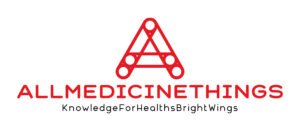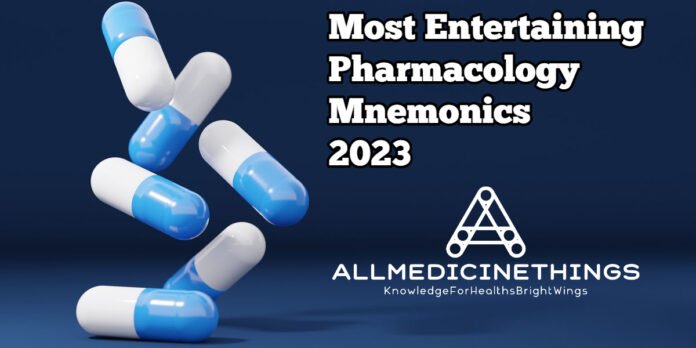Introduction
The study of pharmacology, with its massive lists of drugs, actions, side effects, and contraindications, can make even the most dedicated student’s head spin like a loose pill bottle cap. After the fiftieth drug name, they all start to sound like something from a sci-fi novel or rejected names for pop bands. How on earth are you supposed to remember that ‘Amlodipine’ is a calcium channel blocker and not the name of an alien overlord?
Enter the trusty mnemonic. These nifty memory aids have been around since ancient times, helping humans remember everything from the order of the planets to the bones in the human hand. However, for our particular application, we are going to take mnemonics and supercharge them with the power of humor. Because if there’s one thing that’s memorable, it’s a good laugh (or even a bad pun!).
MedlinePlus – Understanding Medical Words
Importance of Mnemonics in Pharmacology
Pharmacology is an essential pillar of medical science, and it’s crucial for healthcare professionals to understand the nuances of various medications. A simple mistake, like confusing one drug with another, can have catastrophic consequences. Yet, with thousands of drugs on the market and more being developed every day, keeping track can be a Herculean task.
Mnemonics serve as a bridge between the vast ocean of information and the tiny island of our memory. They help condense complex details into bite-sized, digestible chunks that stick in our brains. Think of them as the post-it notes of your mental world – colorful, concise, and always there when you need a quick reminder.
Scientific American – The Importance of Mnemonics
Humor as a Memory Aid
Laughter isn’t just the best medicine; it’s also a powerful memory booster. Studies have shown that we remember funny things better than non-funny things. Why? Because humor evokes strong emotional reactions, making the information more distinctive and easier to retrieve. Plus, let’s be honest, the process of studying becomes a lot more bearable when it’s sprinkled with giggles.
So, when you combine mnemonics with humor, you’re not just making your study sessions less dreary. You’re turbo-charging your memory, making sure that when you’re faced with a critical decision, the right information pops up in your mind, garnished with a sprinkle of laughter.
Ready to dive into the world of hilarious pharmacology mnemonics? Whether you’re a student, a seasoned pharmacist, or just someone who likes chuckling at clever wordplay, this guide has got something for everyone. Buckle up, and let’s take a whimsical journey through the world of drugs – no prescription required!
Guide to Pharmacology – Drug Classes
1. Marvelous Mnemonics for Drug Classes
Drugs, like people, come in various shapes and sizes. And while you might use Instagram or Facebook to categorize your friends, for drugs, we use classes. Understanding these drug classes is like getting the cheat code to the game of pharmacology. Once you’ve cracked the code, everything becomes a tad bit easier. So, let’s unveil some of the most entertaining mnemonics to keep these drug classes straight, shall we?
a. Antibiotics
Mnemonic: “Bacteria’s Lament: ‘Penny’s Cell Tower Might Ruin Our Gig.'”
- Bacteria’s – Beta-lactams
- Lament – Lincosamides
- Penny’s – Penicillins
- Cell – Cephalosporins
- Tower – Tetracyclines
- Might – Macrolides
- Ruin – Rifamycins
- Our – Oxazolidinones
- Gig – Glycopeptides
Bacteria are the main targets of antibiotics, so why not imagine them singing a sorrowful tune about their woes?
b. Antihypertensives
Mnemonic: “Angry Bees Don’t Chase Calcium Cows.”
- Angry – ACE inhibitors (Angiotensin-Converting Enzyme inhibitors)
- Bees – Beta blockers
- Don’t – Diuretics
- Chase – Calcium channel blockers
- Calcium – Centrally acting agents
- Cows – ARBs (Angiotensin II Receptor Blockers)
Antihypertensives keep the pressure down, and honestly, who wouldn’t want to avoid chasing a cow full of calcium?
c. Antipsychotics
Mnemonic: “A Typical Panda Never Quits Tea-Time.”
- A – Atypical antipsychotics
- Typical – Typical antipsychotics
- Panda – Phenothiazines
- Never – Non-phenothiazines
- Quits – Quetiapine
- Tea-Time – Thioxanthenes
When you’re dealing with the complexities of the mind, sometimes it’s fun to bring in a panda who’s quite particular about its tea-time rituals.
d. Antivirals
Mnemonic: “Every Neat Pirate Has Retro Boots.”
- Every – Entry inhibitors
- Neat – Nucleoside reverse transcriptase inhibitors (NRTIs)
- Pirate – Protease inhibitors
- Has – HIV integrase strand transfer inhibitors
- Retro – Reverse transcriptase inhibitors (non-nucleoside)
- Boots – Boosted protease inhibitors
Because, really, if you’re going to fight off viruses, might as well do it in style with some retro boots!
These mnemonics, while whimsical and fun, serve an essential function. They give a playful framework upon which you can add more detailed knowledge. Remember, the more vivid and ridiculous the imagery, the more likely you are to remember it! Onwards to understanding the specifics of how these drugs function, next!
2. Dazzling Drug Mechanism Rhymes
Alright, knowing the classes is just the beginning. It’s time to delve deeper into the fantastical realm of how these drugs actually work. That’s right – it’s mode of action time! But fear not, fellow traveler, for we have crafted some whimsical rhymes to make the journey a joyous one.
a. Mode of Action: Antibiotics
Rhyme: “Bacteria, don’t be sly, ‘cause Penny’s cell might block your sky.”
Explanation:
- Penny’s Cell – Refers to Penicillins and Cephalosporins that inhibit bacterial cell wall synthesis.
- Block Your Sky – These antibiotics prevent bacteria from growing and multiplying.
b. Mode of Action: Antihypertensives
Rhyme: “Angry Bees keep the flow free, while Calcium hides in the tree.”
Explanation:
- Angry Bees – Refers to ACE inhibitors (Angiotensin-Converting Enzyme inhibitors) and Beta blockers which decrease the heart’s workload and widen blood vessels.
- Calcium hides in the tree – Alludes to Calcium channel blockers that prevent calcium from entering the cells of the heart and arteries, leading to a decrease in blood pressure.
c. Mode of Action: Antipsychotics
Rhyme: “Pandas play in dopamine bay, balancing thoughts in a smooth ballet.”
Explanation:
- Pandas Play – Phenothiazines and other antipsychotics, amusingly likened to pandas, primarily act by influencing dopamine pathways in the brain.
- Dopamine Bay & Smooth Ballet – Describes how these drugs balance dopamine levels, ensuring a smoother thought process and alleviating symptoms of psychosis.
d. Mode of Action: Antivirals
Rhyme: “Every pirate sails the viral seas, blocking paths and holding keys.”
Explanation:
- Every Pirate – Evokes imagery of Entry inhibitors and Protease inhibitors which prevent viruses from entering cells and replicating.
- Blocking Paths and Holding Keys – These antivirals act as gatekeepers, preventing the virus from progressing and multiplying.
Imagine the microscopic world teeming with drama as drugs swoop in, waging battles, blocking pathways, and ensuring order. It’s a world where bacteria sing laments, hypertension is kept at bay by bees, pandas dance gracefully, and pirates rule the viral seas. And with these rhymes, you’ve just gotten a VIP pass to understand this microscopic theater! So, whenever you’re lost in the vast sea of pharmacology, let these playful rhymes be your compass, leading you back to clarity.
3. Side Effects Made Sassy
Let’s face it: every good thing often comes with a ‘but.’ Drugs, no matter how life-saving, are no exception. But instead of dreading the lengthy list of potential side effects, let’s sass them up a bit! After all, if they’re going to be a part of the package, might as well have some fun with them, right?
a. Funny Side Effects: Antibiotics
Rhyme: “Penny’s party gave some tummy aches, while rifamycins made the liver shake!”
Explanation:
- Penny’s Party – Penicillins sometimes lead to gastrointestinal issues.
- Rifamycins & Liver Shake – Rifamycins, like Rifampin, have hepatotoxicity as a known side effect, potentially causing liver issues.
b. Lively Lines for Antihypertensive Side Effects
Rhyme: “Bee stings cause a swollen toe, calcium blockers make the ankle flow.”
Explanation:
- Bee Stings & Swollen Toe – Beta blockers can sometimes lead to edema, or swelling, especially in the extremities like toes.
- Calcium Blockers & Ankle Flow – Calcium channel blockers, while effective for blood pressure, might also cause ankle edema.
c. Chuckles for Antipsychotic Side Effects
Rhyme: “Dancing pandas sometimes fall, in a sleepy trance or with a weighty call.”
Explanation:
- Dancing Pandas & Sleepy Trance – Many antipsychotics, especially the atypical ones, might lead to drowsiness or sedation.
- Weighty Call – Weight gain is another common side effect associated with several antipsychotic medications.
d. Vibrant Verses for Antiviral Side Effects
Rhyme: “Pirates, with their viral spree, sometimes feel nausea on the open sea.”
Explanation:
- Pirates & Viral Spree – Referring to antivirals and their function.
- Nausea on the Open Sea – Many antiviral medications have gastrointestinal disturbances like nausea as a side effect.
In the grand theater of pharmacology, side effects are the unplanned improvisations. They might not be the main act, but they sure demand attention. And now, with these sassy verses, you’ve got a cheeky way to remember them. Sure, they may be unwanted guests, but with a hint of humor, even the most uninvited guest becomes a tad bit more tolerable. Remember, it’s all in the perspective! Up next: those situations where the stars of our show – the drugs – might just need to take a backseat. Stay tuned!
4. Contraindications with a Twist
Contraindications are the “Don’t you dare!” of the drug world. These are the situations where, even if the drug might seem beneficial, it’s best left on the shelf. But instead of viewing contraindications as mere restrictions, let’s give them a humorous spin. After all, who said caution can’t come with a chuckle?
a. Chucklesome Contraindications: Antibiotics
Rhyme: “In Penny’s world of allergy flair, cephalosporins tread with care.”
Explanation:
- Penny’s World & Allergy Flair – Refers to the notorious allergies associated with Penicillins. If someone’s allergic to penicillin, caution is needed when prescribing cephalosporins due to cross-reactivity.
b. Laughing at the Limits: Antihypertensives
Rhyme: “Bee’s buzz might seem quite neat, but with asthma, it faces defeat.”
Explanation:
- Bee’s Buzz & Asthma – Beta blockers (the bees) can exacerbate asthma symptoms, making them a risky choice for those with the condition.
c. Jovial Jabs at Antipsychotic No-Nos
Rhyme: “When pandas party with Parkinson’s crew, their dance moves become a little askew.”
Explanation:
- Pandas Party & Parkinson’s Crew – Many antipsychotics, which act on dopamine pathways, can worsen symptoms in Parkinson’s disease patients, as their condition is related to dopamine deficiency.
d. Giggle-Inducing Gotchas: Antivirals
Rhyme: “Pirate’s treasure isn’t for all; with liver issues, beware the haul.”
Explanation:
- Pirate’s Treasure & Liver Issues – Several antiviral drugs are metabolized in the liver, making them potentially problematic for those with liver conditions.
Imagine contraindications as the quirky rules of an exclusive club. Not everyone gets in, and sometimes the reasons might seem a bit odd. But it’s all in the name of safety! And as you maneuver the maze of medications, these jolly jingles will hopefully be your guiding light, ensuring that while you might be laughing on the outside, you’re serious about safety on the inside. Coming up, we’ll test your mnemonic mastery. Ready to play?
Mind Tools – Memory Improvement Techniques
5. The Ultimate Mnemonic Challenge: Test Your Wit!
Now that we’ve covered a plethora of playful pharmacological mnemonics, rhymes, and jingles, it’s time to see how well they’ve stuck. But don’t worry, this isn’t your standard pop quiz. It’s a challenge with a side of sass and a sprinkle of humor. Let’s get started!
a. The Antibiotic Acrostic Adventure
Challenge: “In a world where ‘Bacteria’s Lament’ rings loud, which antibiotics make them less proud?”
Hint: Think about our jingle, “Bacteria’s Lament: ‘Penny’s Cell Tower Might Ruin Our Gig.'”
Your Answer: In the Comments
b. Hypertensive Hints and Puzzles
Challenge: “When blood pressures rise and tensions peak, which duo keeps the arteries from a leak?”
Hint: Angry Bees don’t chase what?
Your Answer: In the comments
c. Psychedelic Antipsychotic Puzzler
Challenge: “In a world where pandas have their tea-time spree, which class balances the brain’s dopamine glee?”
Hint: Recall the line about dancing pandas and dopamine bay.
Your Answer: In the Comments
d. Viral Voyage Conundrum
Challenge: “On the vast, open viral sea, which pirates block paths with glee?”
Hint: Think about the vibrant verses that spoke of pirates and their antics on the open seas.
Your Answer: In the Comments
Ahoy, memory explorer! How did you fare on this whimsical journey through the world of pharmacology mnemonics? Remember, even if you stumbled on a challenge or two, the goal here is to enjoy the learning process and let the melodies and rhymes enhance your memory’s dance. Keep humming, keep rhyming, and let the world of drugs become a harmonious symphony in your mind! And as always, happy learning!
Conclusion: The Harmonious Symphony of Humorous Pharmacology
If pharmacology were a song, then mnemonics would be its catchy chorus – the part you hum long after the tune is over. In this lively dive into the realm of drug knowledge, we’ve seen that learning doesn’t have to be a dry, daunting task. In fact, it can be a theatrical performance filled with drama, laughter, and even a few unexpected twists and turns.
By transforming drug classes, mechanisms, side effects, and contraindications into whimsical rhymes and sassy stories, we’ve embarked on a journey that’s both informative and entertaining. From bacteria singing laments to dancing pandas and adventurous pirates, we’ve personified pharmacology in a way that’s memorable and enjoyable.
So, the next time you find yourself knee-deep in medical jargon or lost in a sea of drug information, remember the tales and tunes we’ve shared today. Let them be your lighthouse, guiding you back to clarity and understanding. After all, the world of medicine might be vast and complex, but with the right mnemonics by your side, navigating it becomes a delightful dance.
In the end, whether you’re a student, a practitioner, or just a curious soul, always remember: pharmacology, at its heart, is a story. And with each mnemonic, rhyme, and riddle, you’re not just memorizing facts – you’re becoming a part of that story.
So, here’s to making learning a joy, to embracing the humor amidst the complexities, and to forever cherishing the playful symphony of pharmacology. Until our next mnemonic-filled rendezvous, don’t forget to check the comments and comment your answers as well. Stay curious and keep humming!





